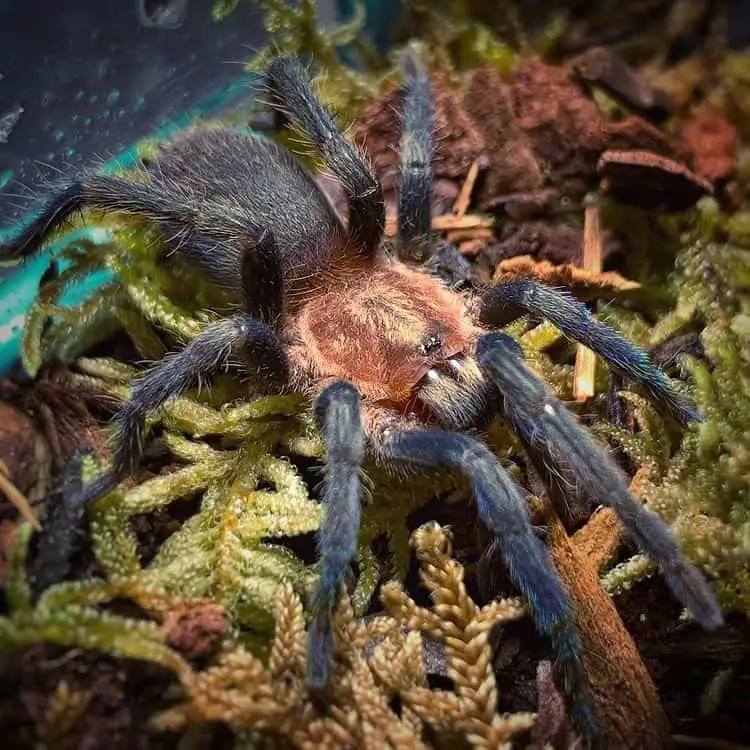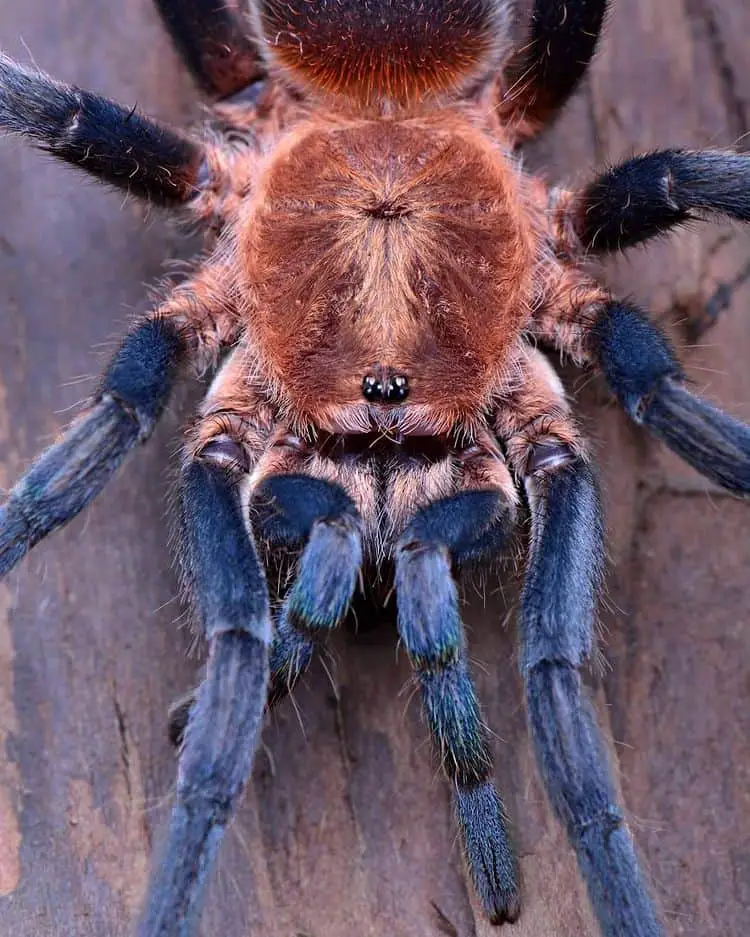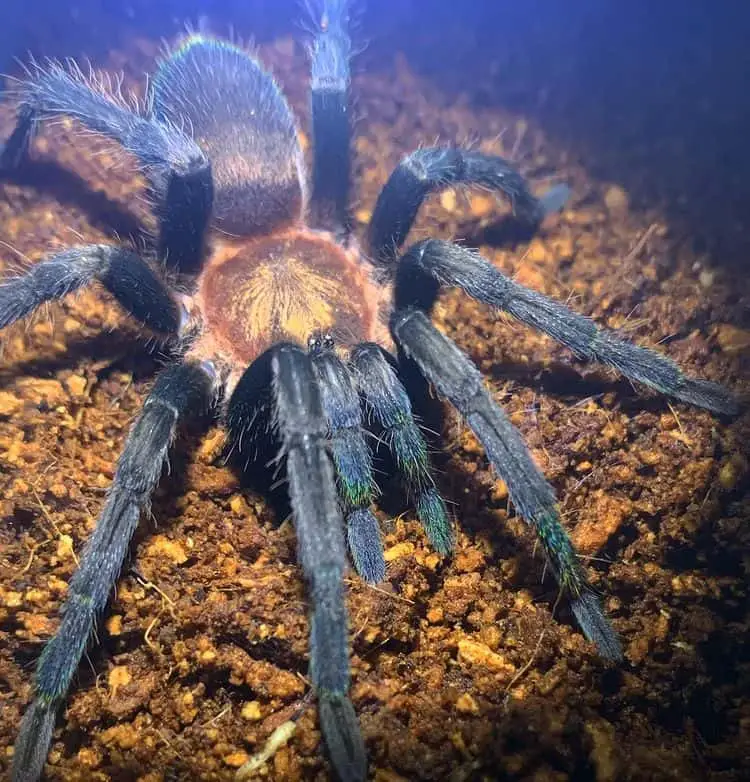The Trinidad Pink Tarantula (Holothele Longipes) is a New World Terrestrial species native to Trinidad and Tobago as well as Venezuela. This spider is highly desired among tarantula collectors for its amazing coloration and small size.
If you’re considering adding a Trinidad Pink Tarantula to your collection, here is everything you need to know about this wonderful species!

Trinidad Pink Tarantula Care Sheet
| Name of Species | Holothele Longipes |
| Family | Theraphosidae |
| Common names | Trinidad Pink Tarantula |
| Native location | Trinidad and Tobago / Venezuela |
| Category | New World |
| Type | Terrestrial |
| Leg span | 2 to 2.75 inches |
| Growth speed | Fast |
| Urticating hairs | Yes |
| Diet | Insects, primarily roaches & crickets |
| Social | Solitary |
| Temperature | 70 to 80 °F |
| Humidity | 75 to 85% |
| Life span | Females: 5 to 10 years / Males: ~2 years |
| Experience level | Beginner |
Trinidad Pink Tarantula Overview
The Trinidad Pink Tarantula, also known as the Holothele Longipes, used to be known as the Holothele Sanguiniceps.
It is a dwarf tarantula that naturally inhabits Trinidad and Tobago and Venezuela.
This spider is a tropical species that is mainly terrestrial with a tendency to burrow.
Appearance

The Trinidad Pink Tarantula is very well known for its gorgeous, colorful appearance. As adults, they exhibit stunning dark legs that are metallic black/blue in color and a striking pale, orangeish coloration on parts of their carapace and abdomen, giving them a very unique look.
Another thing that’s quite special about these spiders is that they’re very small. Fully grown, they typically do not grow bigger than 2.75 inches, making them one of the smaller species in the hobby.
Females are typically a bit larger than males, but both are very small. Though they are small, they have a very fast growth rate.
Price
There are a variety of websites that have Trinidad Pink Tarantulas for sale. The price typically depends on the age of the specimen, as well as whether it’s a male or a female.
(Sub)adult females are typically the most expensive but are still relatively affordable.
The price depends on where you buy them, but typically, you can expect to pay around $25 to $45 for a sling/juvenile.
Behavior and Temperament
The Trinidad Pink Tarantula is quite docile and therefore decently suitable for beginners. They do not have a tendency to display defensive behavior and would rather run from threats than face them head-on.
A threat posture is rare from this species and they almost never bite. As with all tarantula species, they do have venom, but it is very mild.
They also have urticating hairs and are known to kick them when they feel threatened, so that is something to watch out for.
In addition, the Trinidad Pink Tarantula is known for being extremely fast. They can run at very high speeds, which can catch some people by surprise. They are also very skittish and have a high tendency to run and flee from anything that scares them, which can make rehousing them sometimes difficult. They also are quite heavy webbers.
Caring for a Trinidad Pink Tarantula

Temperature and humidity
Since the Trinidad Pink Tarantula is from a tropical environment, they need relatively high temperatures and humidity levels in order to thrive. We want to mimic the climate that they naturally inhabit as closely as possible.
Typically, a temperature between 70 and 80°F and humidity between 75 and 85% is good for them.
Tank setup
The Trinidad Pink Tarantula is a small species so they do not need a very large enclosure, an enclosure with a size of 12″ x 12″ x 12″ would be plenty of space for an adult specimen, but you can even go a little bit smaller if you need to. Slings and juveniles can be housed in much smaller spaces, as long as you rehouse them as they get bigger.
Since this is a terrestrial spider, prioritize the length and width of the enclosure over height. They will not climb, so a lot of vertical space is not necessary.
You can decorate their enclosure with a few hiding spaces, fake foliage, and rocks, though the spider will likely spend most of its time in its burrow.
Adequate ventilation in their enclosure is also important to avoid the growth of bacteria and mold.
Substrate
Your Trinidad Pink Tarantula will need enough substrate to create a burrow. Provide them with a layer of substrate that’s around 4 inches thick so that they can create their burrow.
Good material to use as substrate is a mixture of peat moss, coconut fiber, and soil.
Social
Unfortunately, there is not enough information available about the communal life of the Holothele Longipes. As a result, I recommend against placing them in a communal enclosure as this can result in cannibalism.
Molting
Like all tarantula species, the Trinidad Pink will occasionally molt. In fact, they will do this more frequently than many other species due to their fast growth rate.
You can tell that your tarantula is about to molt because they will refuse to eat for a few days. During the molt, it is very important that you do not disturb them. Failed molts can result in the loss of limbs and even death.
After the molt, refrain from feeding them for a few days to give their fangs time to harden.
Diet & Feeding
The Trinidad Pink Tarantula uses its extremely fast speed to tackle and take down prey, which can be an interesting sight to watch.
They should be fed a diet that consists of insects such as crickets and small roaches.
However, what they should eat also depends on their size.
Slings should be fed flightless fruit flies or parts of pre-killed insects.
As they grow larger, the size of the prey should grow with them. Juveniles can eat pinhead crickets.
Fully grown, the Trinidad Pink is still relatively small. As such, make sure that you do not feed them crickets or roaches that are larger than the spider’s abdomen.
As for drinking, you should provide them with a shallow water dish.
Health & Lifespan
The Trinidad Pink Tarantula does not have a particularly long lifespan. Females typically live for 5 to 10 years, while males only live for about 2 years.
Keeping them in good health is luckily not too difficult. The biggest threats they face in captivity are mold, bacteria, and parasites.
To prevent mold and bacterial growth, make sure that they have enough ventilation in their enclosure. In addition, ensure that uneaten food and shed molts are removed in a timely matter.
Preventing parasites can be achieved by feeding them high-quality feeder insects that are captive-bred.
Holothele Longipes Facts
- This species used to be known as the Holothele Sanguinicpes but had its species name changed.
- It was first discovered in 1875 by Koch.
- The Holothele genus was first placed with the curtain-web spiders before it was transferred to the Theraphosidae family in 1980.
Final words
The Trinidad Pink Tarantula is an enigmatic species that does not have much written about it. Nevertheless, many people are interested in this spider due to its stunning color, docile temperament, and small size.
Whether experienced or beginner, this arachnid has something to offer to everyone. They’re easy to care for, beautiful to look at, and a great addition to any collection!
- How Long Do American Eskimo Dogs Live? Important Factors and Care Tips - September 29, 2023
- Do American Bulldogs Need Grooming? Essential Tips and Care Guidelines - September 29, 2023
- Do Bengal Cats Enjoy Playing? Essential Tips for Keeping Them Active - September 29, 2023